Examining Inclusion Practices in Early Childhood Education AU
VerifiedAdded on 2023/06/06
|13
|3556
|418
Essay
AI Summary
This essay critically analyzes inclusion practices in early childhood education in Australia, focusing on the Inclusion Support Programme introduced in 2016. It highlights the broadened definition of disability to include cultural background and linguistic incapabilities, facilitating the inclusion of children aged 0-5 from diverse backgrounds. The essay also addresses criticisms of the national education policy, such as the overemphasis on English, low participation rates in early learning, lack of research, and absence of gender sensitivity teaching. It explores theoretical approaches to fostering tolerance, including the use of visual aids and teaching about diversity, while also discussing the debate around integrating children with disabilities into mainstream education. Furthermore, it emphasizes the role of family and society in shaping educators' pedagogical practices, viewing education as a collaborative effort to improve the society. The essay concludes by highlighting the importance of involving family and society in the education process to foster a vibrant civil society.

Running head: INCLUSION PRACTICES IN EARLY CHILDHOOD
Inclusion Practices in Early Childhood
Name of the Student
Name of the University
Author Note
Inclusion Practices in Early Childhood
Name of the Student
Name of the University
Author Note
Paraphrase This Document
Need a fresh take? Get an instant paraphrase of this document with our AI Paraphraser
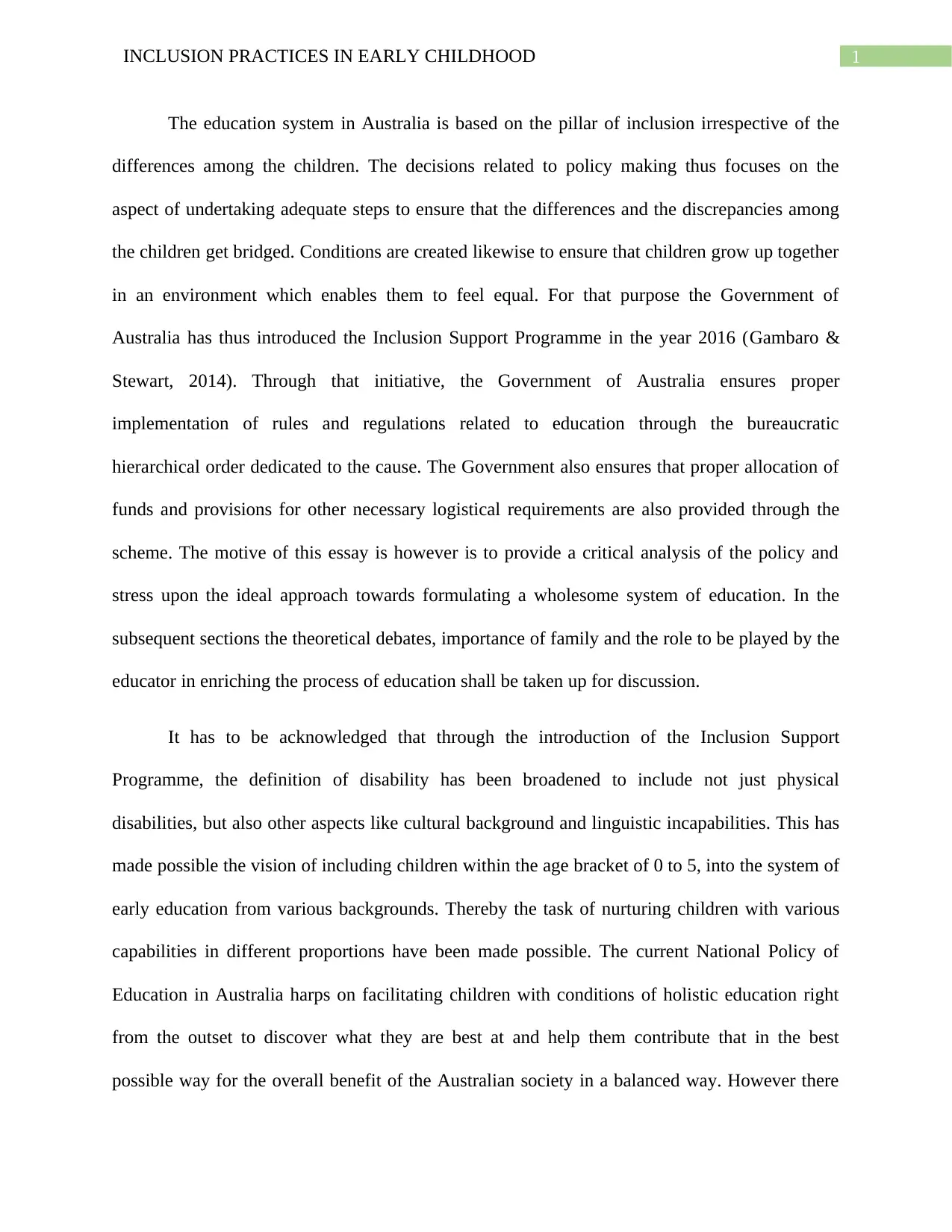
1INCLUSION PRACTICES IN EARLY CHILDHOOD
The education system in Australia is based on the pillar of inclusion irrespective of the
differences among the children. The decisions related to policy making thus focuses on the
aspect of undertaking adequate steps to ensure that the differences and the discrepancies among
the children get bridged. Conditions are created likewise to ensure that children grow up together
in an environment which enables them to feel equal. For that purpose the Government of
Australia has thus introduced the Inclusion Support Programme in the year 2016 (Gambaro &
Stewart, 2014). Through that initiative, the Government of Australia ensures proper
implementation of rules and regulations related to education through the bureaucratic
hierarchical order dedicated to the cause. The Government also ensures that proper allocation of
funds and provisions for other necessary logistical requirements are also provided through the
scheme. The motive of this essay is however is to provide a critical analysis of the policy and
stress upon the ideal approach towards formulating a wholesome system of education. In the
subsequent sections the theoretical debates, importance of family and the role to be played by the
educator in enriching the process of education shall be taken up for discussion.
It has to be acknowledged that through the introduction of the Inclusion Support
Programme, the definition of disability has been broadened to include not just physical
disabilities, but also other aspects like cultural background and linguistic incapabilities. This has
made possible the vision of including children within the age bracket of 0 to 5, into the system of
early education from various backgrounds. Thereby the task of nurturing children with various
capabilities in different proportions have been made possible. The current National Policy of
Education in Australia harps on facilitating children with conditions of holistic education right
from the outset to discover what they are best at and help them contribute that in the best
possible way for the overall benefit of the Australian society in a balanced way. However there
The education system in Australia is based on the pillar of inclusion irrespective of the
differences among the children. The decisions related to policy making thus focuses on the
aspect of undertaking adequate steps to ensure that the differences and the discrepancies among
the children get bridged. Conditions are created likewise to ensure that children grow up together
in an environment which enables them to feel equal. For that purpose the Government of
Australia has thus introduced the Inclusion Support Programme in the year 2016 (Gambaro &
Stewart, 2014). Through that initiative, the Government of Australia ensures proper
implementation of rules and regulations related to education through the bureaucratic
hierarchical order dedicated to the cause. The Government also ensures that proper allocation of
funds and provisions for other necessary logistical requirements are also provided through the
scheme. The motive of this essay is however is to provide a critical analysis of the policy and
stress upon the ideal approach towards formulating a wholesome system of education. In the
subsequent sections the theoretical debates, importance of family and the role to be played by the
educator in enriching the process of education shall be taken up for discussion.
It has to be acknowledged that through the introduction of the Inclusion Support
Programme, the definition of disability has been broadened to include not just physical
disabilities, but also other aspects like cultural background and linguistic incapabilities. This has
made possible the vision of including children within the age bracket of 0 to 5, into the system of
early education from various backgrounds. Thereby the task of nurturing children with various
capabilities in different proportions have been made possible. The current National Policy of
Education in Australia harps on facilitating children with conditions of holistic education right
from the outset to discover what they are best at and help them contribute that in the best
possible way for the overall benefit of the Australian society in a balanced way. However there
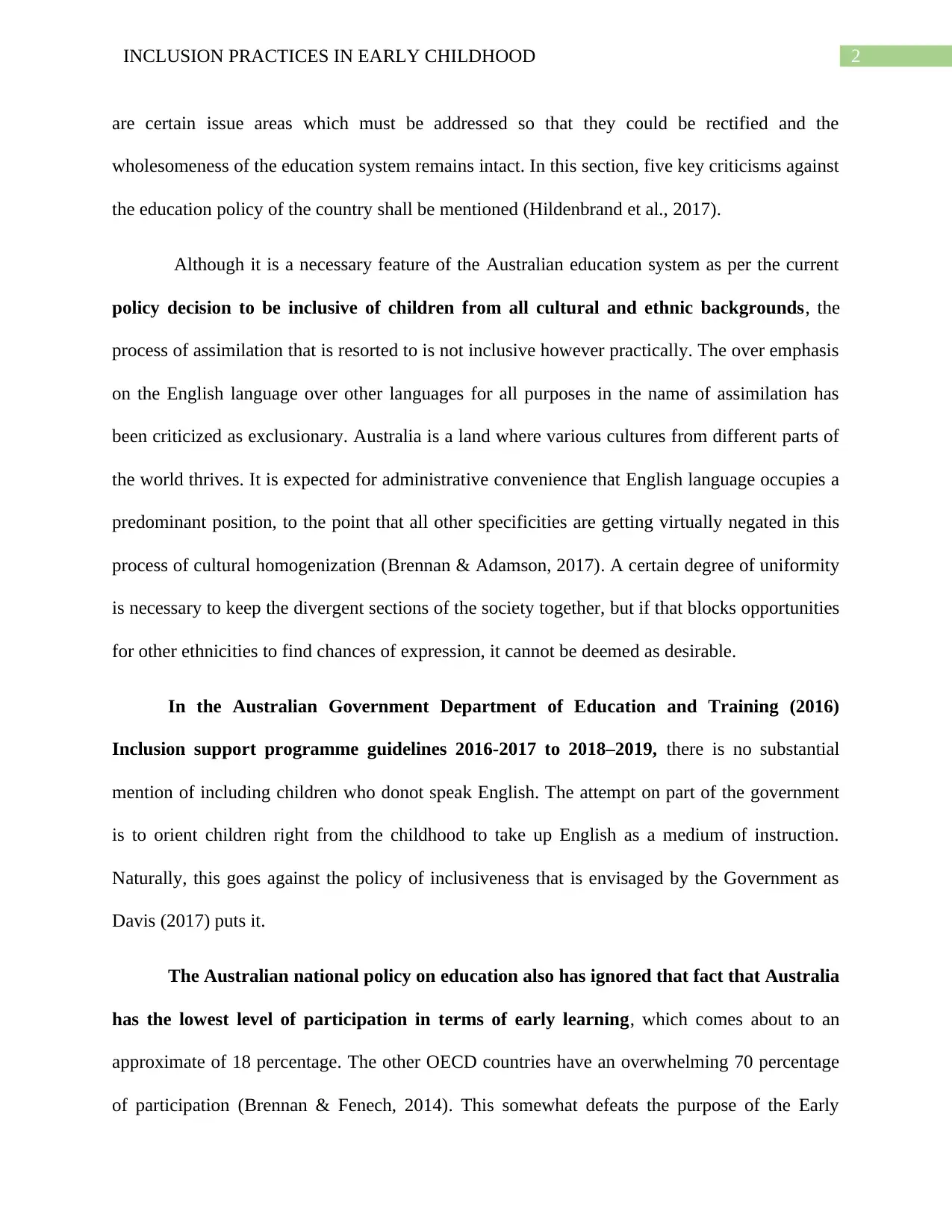
2INCLUSION PRACTICES IN EARLY CHILDHOOD
are certain issue areas which must be addressed so that they could be rectified and the
wholesomeness of the education system remains intact. In this section, five key criticisms against
the education policy of the country shall be mentioned (Hildenbrand et al., 2017).
Although it is a necessary feature of the Australian education system as per the current
policy decision to be inclusive of children from all cultural and ethnic backgrounds, the
process of assimilation that is resorted to is not inclusive however practically. The over emphasis
on the English language over other languages for all purposes in the name of assimilation has
been criticized as exclusionary. Australia is a land where various cultures from different parts of
the world thrives. It is expected for administrative convenience that English language occupies a
predominant position, to the point that all other specificities are getting virtually negated in this
process of cultural homogenization (Brennan & Adamson, 2017). A certain degree of uniformity
is necessary to keep the divergent sections of the society together, but if that blocks opportunities
for other ethnicities to find chances of expression, it cannot be deemed as desirable.
In the Australian Government Department of Education and Training (2016)
Inclusion support programme guidelines 2016-2017 to 2018–2019, there is no substantial
mention of including children who donot speak English. The attempt on part of the government
is to orient children right from the childhood to take up English as a medium of instruction.
Naturally, this goes against the policy of inclusiveness that is envisaged by the Government as
Davis (2017) puts it.
The Australian national policy on education also has ignored that fact that Australia
has the lowest level of participation in terms of early learning, which comes about to an
approximate of 18 percentage. The other OECD countries have an overwhelming 70 percentage
of participation (Brennan & Fenech, 2014). This somewhat defeats the purpose of the Early
are certain issue areas which must be addressed so that they could be rectified and the
wholesomeness of the education system remains intact. In this section, five key criticisms against
the education policy of the country shall be mentioned (Hildenbrand et al., 2017).
Although it is a necessary feature of the Australian education system as per the current
policy decision to be inclusive of children from all cultural and ethnic backgrounds, the
process of assimilation that is resorted to is not inclusive however practically. The over emphasis
on the English language over other languages for all purposes in the name of assimilation has
been criticized as exclusionary. Australia is a land where various cultures from different parts of
the world thrives. It is expected for administrative convenience that English language occupies a
predominant position, to the point that all other specificities are getting virtually negated in this
process of cultural homogenization (Brennan & Adamson, 2017). A certain degree of uniformity
is necessary to keep the divergent sections of the society together, but if that blocks opportunities
for other ethnicities to find chances of expression, it cannot be deemed as desirable.
In the Australian Government Department of Education and Training (2016)
Inclusion support programme guidelines 2016-2017 to 2018–2019, there is no substantial
mention of including children who donot speak English. The attempt on part of the government
is to orient children right from the childhood to take up English as a medium of instruction.
Naturally, this goes against the policy of inclusiveness that is envisaged by the Government as
Davis (2017) puts it.
The Australian national policy on education also has ignored that fact that Australia
has the lowest level of participation in terms of early learning, which comes about to an
approximate of 18 percentage. The other OECD countries have an overwhelming 70 percentage
of participation (Brennan & Fenech, 2014). This somewhat defeats the purpose of the Early
⊘ This is a preview!⊘
Do you want full access?
Subscribe today to unlock all pages.

Trusted by 1+ million students worldwide
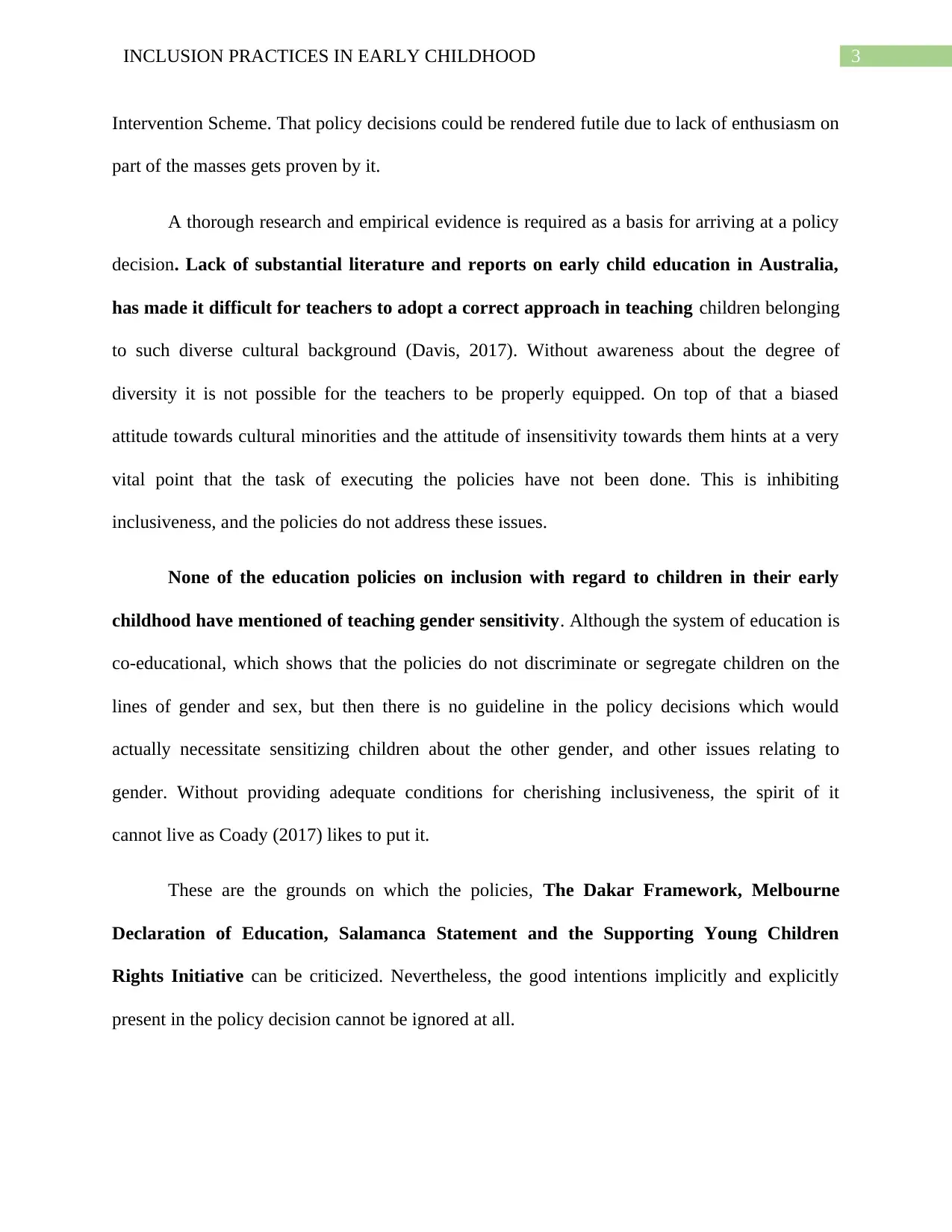
3INCLUSION PRACTICES IN EARLY CHILDHOOD
Intervention Scheme. That policy decisions could be rendered futile due to lack of enthusiasm on
part of the masses gets proven by it.
A thorough research and empirical evidence is required as a basis for arriving at a policy
decision. Lack of substantial literature and reports on early child education in Australia,
has made it difficult for teachers to adopt a correct approach in teaching children belonging
to such diverse cultural background (Davis, 2017). Without awareness about the degree of
diversity it is not possible for the teachers to be properly equipped. On top of that a biased
attitude towards cultural minorities and the attitude of insensitivity towards them hints at a very
vital point that the task of executing the policies have not been done. This is inhibiting
inclusiveness, and the policies do not address these issues.
None of the education policies on inclusion with regard to children in their early
childhood have mentioned of teaching gender sensitivity. Although the system of education is
co-educational, which shows that the policies do not discriminate or segregate children on the
lines of gender and sex, but then there is no guideline in the policy decisions which would
actually necessitate sensitizing children about the other gender, and other issues relating to
gender. Without providing adequate conditions for cherishing inclusiveness, the spirit of it
cannot live as Coady (2017) likes to put it.
These are the grounds on which the policies, The Dakar Framework, Melbourne
Declaration of Education, Salamanca Statement and the Supporting Young Children
Rights Initiative can be criticized. Nevertheless, the good intentions implicitly and explicitly
present in the policy decision cannot be ignored at all.
Intervention Scheme. That policy decisions could be rendered futile due to lack of enthusiasm on
part of the masses gets proven by it.
A thorough research and empirical evidence is required as a basis for arriving at a policy
decision. Lack of substantial literature and reports on early child education in Australia,
has made it difficult for teachers to adopt a correct approach in teaching children belonging
to such diverse cultural background (Davis, 2017). Without awareness about the degree of
diversity it is not possible for the teachers to be properly equipped. On top of that a biased
attitude towards cultural minorities and the attitude of insensitivity towards them hints at a very
vital point that the task of executing the policies have not been done. This is inhibiting
inclusiveness, and the policies do not address these issues.
None of the education policies on inclusion with regard to children in their early
childhood have mentioned of teaching gender sensitivity. Although the system of education is
co-educational, which shows that the policies do not discriminate or segregate children on the
lines of gender and sex, but then there is no guideline in the policy decisions which would
actually necessitate sensitizing children about the other gender, and other issues relating to
gender. Without providing adequate conditions for cherishing inclusiveness, the spirit of it
cannot live as Coady (2017) likes to put it.
These are the grounds on which the policies, The Dakar Framework, Melbourne
Declaration of Education, Salamanca Statement and the Supporting Young Children
Rights Initiative can be criticized. Nevertheless, the good intentions implicitly and explicitly
present in the policy decision cannot be ignored at all.
Paraphrase This Document
Need a fresh take? Get an instant paraphrase of this document with our AI Paraphraser
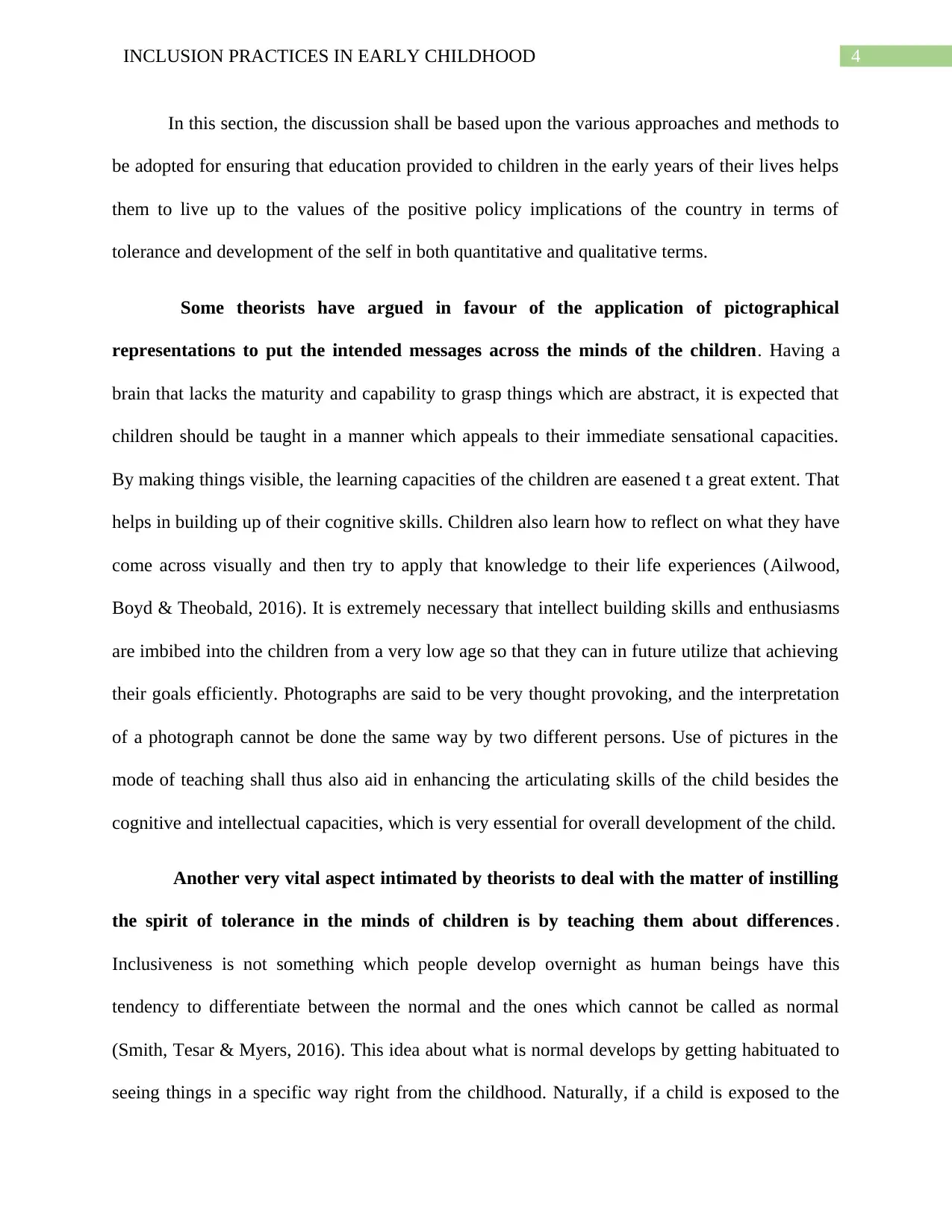
4INCLUSION PRACTICES IN EARLY CHILDHOOD
In this section, the discussion shall be based upon the various approaches and methods to
be adopted for ensuring that education provided to children in the early years of their lives helps
them to live up to the values of the positive policy implications of the country in terms of
tolerance and development of the self in both quantitative and qualitative terms.
Some theorists have argued in favour of the application of pictographical
representations to put the intended messages across the minds of the children. Having a
brain that lacks the maturity and capability to grasp things which are abstract, it is expected that
children should be taught in a manner which appeals to their immediate sensational capacities.
By making things visible, the learning capacities of the children are easened t a great extent. That
helps in building up of their cognitive skills. Children also learn how to reflect on what they have
come across visually and then try to apply that knowledge to their life experiences (Ailwood,
Boyd & Theobald, 2016). It is extremely necessary that intellect building skills and enthusiasms
are imbibed into the children from a very low age so that they can in future utilize that achieving
their goals efficiently. Photographs are said to be very thought provoking, and the interpretation
of a photograph cannot be done the same way by two different persons. Use of pictures in the
mode of teaching shall thus also aid in enhancing the articulating skills of the child besides the
cognitive and intellectual capacities, which is very essential for overall development of the child.
Another very vital aspect intimated by theorists to deal with the matter of instilling
the spirit of tolerance in the minds of children is by teaching them about differences .
Inclusiveness is not something which people develop overnight as human beings have this
tendency to differentiate between the normal and the ones which cannot be called as normal
(Smith, Tesar & Myers, 2016). This idea about what is normal develops by getting habituated to
seeing things in a specific way right from the childhood. Naturally, if a child is exposed to the
In this section, the discussion shall be based upon the various approaches and methods to
be adopted for ensuring that education provided to children in the early years of their lives helps
them to live up to the values of the positive policy implications of the country in terms of
tolerance and development of the self in both quantitative and qualitative terms.
Some theorists have argued in favour of the application of pictographical
representations to put the intended messages across the minds of the children. Having a
brain that lacks the maturity and capability to grasp things which are abstract, it is expected that
children should be taught in a manner which appeals to their immediate sensational capacities.
By making things visible, the learning capacities of the children are easened t a great extent. That
helps in building up of their cognitive skills. Children also learn how to reflect on what they have
come across visually and then try to apply that knowledge to their life experiences (Ailwood,
Boyd & Theobald, 2016). It is extremely necessary that intellect building skills and enthusiasms
are imbibed into the children from a very low age so that they can in future utilize that achieving
their goals efficiently. Photographs are said to be very thought provoking, and the interpretation
of a photograph cannot be done the same way by two different persons. Use of pictures in the
mode of teaching shall thus also aid in enhancing the articulating skills of the child besides the
cognitive and intellectual capacities, which is very essential for overall development of the child.
Another very vital aspect intimated by theorists to deal with the matter of instilling
the spirit of tolerance in the minds of children is by teaching them about differences .
Inclusiveness is not something which people develop overnight as human beings have this
tendency to differentiate between the normal and the ones which cannot be called as normal
(Smith, Tesar & Myers, 2016). This idea about what is normal develops by getting habituated to
seeing things in a specific way right from the childhood. Naturally, if a child is exposed to the
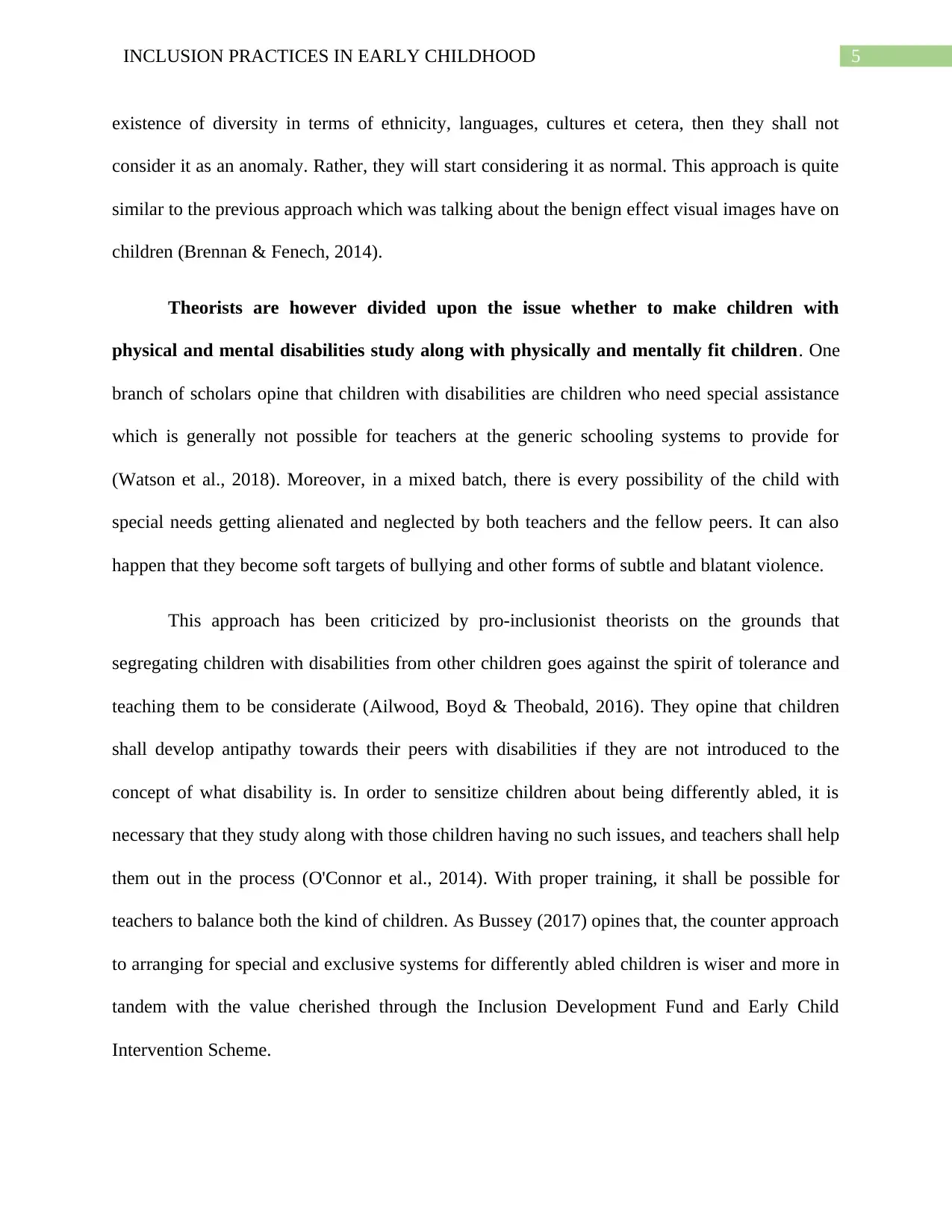
5INCLUSION PRACTICES IN EARLY CHILDHOOD
existence of diversity in terms of ethnicity, languages, cultures et cetera, then they shall not
consider it as an anomaly. Rather, they will start considering it as normal. This approach is quite
similar to the previous approach which was talking about the benign effect visual images have on
children (Brennan & Fenech, 2014).
Theorists are however divided upon the issue whether to make children with
physical and mental disabilities study along with physically and mentally fit children. One
branch of scholars opine that children with disabilities are children who need special assistance
which is generally not possible for teachers at the generic schooling systems to provide for
(Watson et al., 2018). Moreover, in a mixed batch, there is every possibility of the child with
special needs getting alienated and neglected by both teachers and the fellow peers. It can also
happen that they become soft targets of bullying and other forms of subtle and blatant violence.
This approach has been criticized by pro-inclusionist theorists on the grounds that
segregating children with disabilities from other children goes against the spirit of tolerance and
teaching them to be considerate (Ailwood, Boyd & Theobald, 2016). They opine that children
shall develop antipathy towards their peers with disabilities if they are not introduced to the
concept of what disability is. In order to sensitize children about being differently abled, it is
necessary that they study along with those children having no such issues, and teachers shall help
them out in the process (O'Connor et al., 2014). With proper training, it shall be possible for
teachers to balance both the kind of children. As Bussey (2017) opines that, the counter approach
to arranging for special and exclusive systems for differently abled children is wiser and more in
tandem with the value cherished through the Inclusion Development Fund and Early Child
Intervention Scheme.
existence of diversity in terms of ethnicity, languages, cultures et cetera, then they shall not
consider it as an anomaly. Rather, they will start considering it as normal. This approach is quite
similar to the previous approach which was talking about the benign effect visual images have on
children (Brennan & Fenech, 2014).
Theorists are however divided upon the issue whether to make children with
physical and mental disabilities study along with physically and mentally fit children. One
branch of scholars opine that children with disabilities are children who need special assistance
which is generally not possible for teachers at the generic schooling systems to provide for
(Watson et al., 2018). Moreover, in a mixed batch, there is every possibility of the child with
special needs getting alienated and neglected by both teachers and the fellow peers. It can also
happen that they become soft targets of bullying and other forms of subtle and blatant violence.
This approach has been criticized by pro-inclusionist theorists on the grounds that
segregating children with disabilities from other children goes against the spirit of tolerance and
teaching them to be considerate (Ailwood, Boyd & Theobald, 2016). They opine that children
shall develop antipathy towards their peers with disabilities if they are not introduced to the
concept of what disability is. In order to sensitize children about being differently abled, it is
necessary that they study along with those children having no such issues, and teachers shall help
them out in the process (O'Connor et al., 2014). With proper training, it shall be possible for
teachers to balance both the kind of children. As Bussey (2017) opines that, the counter approach
to arranging for special and exclusive systems for differently abled children is wiser and more in
tandem with the value cherished through the Inclusion Development Fund and Early Child
Intervention Scheme.
⊘ This is a preview!⊘
Do you want full access?
Subscribe today to unlock all pages.

Trusted by 1+ million students worldwide
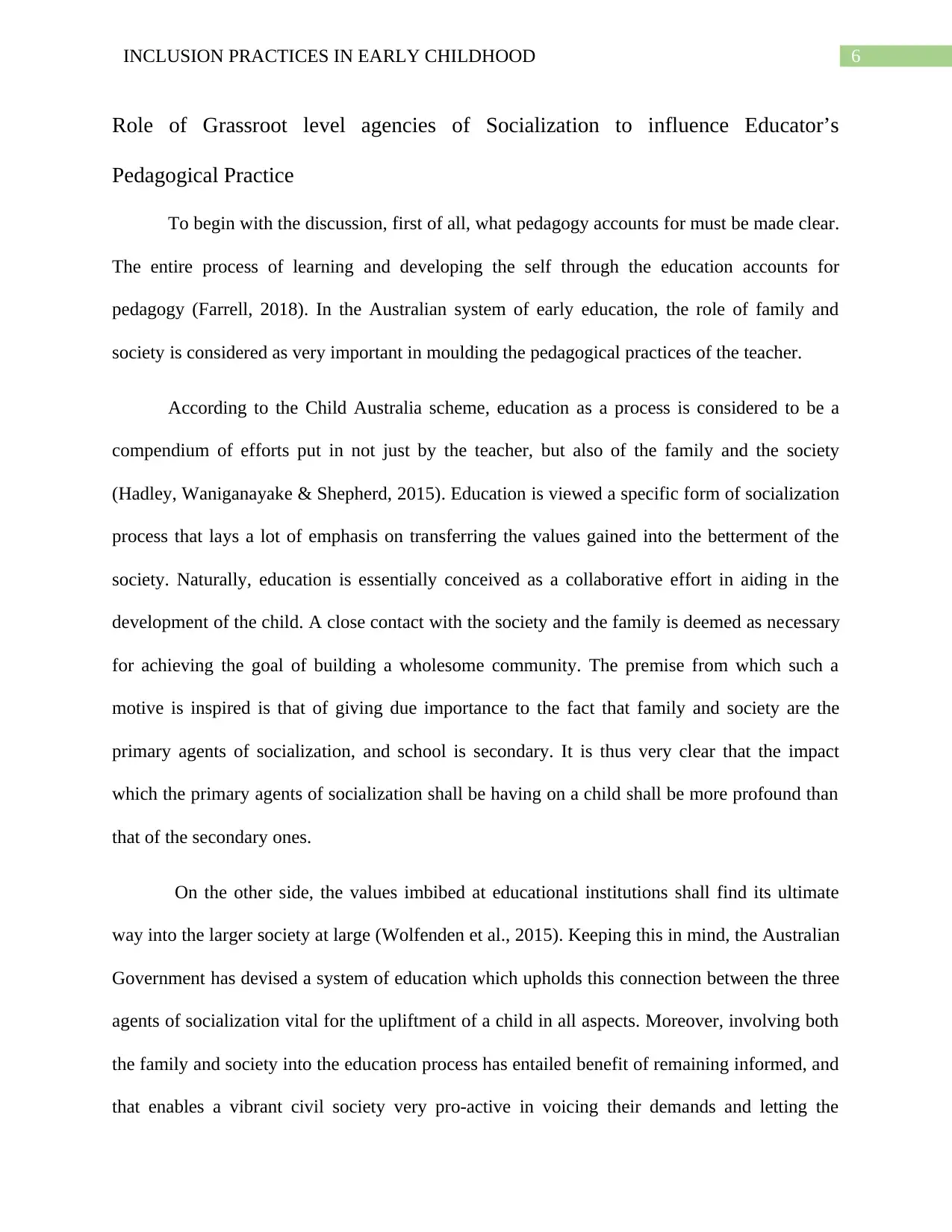
6INCLUSION PRACTICES IN EARLY CHILDHOOD
Role of Grassroot level agencies of Socialization to influence Educator’s
Pedagogical Practice
To begin with the discussion, first of all, what pedagogy accounts for must be made clear.
The entire process of learning and developing the self through the education accounts for
pedagogy (Farrell, 2018). In the Australian system of early education, the role of family and
society is considered as very important in moulding the pedagogical practices of the teacher.
According to the Child Australia scheme, education as a process is considered to be a
compendium of efforts put in not just by the teacher, but also of the family and the society
(Hadley, Waniganayake & Shepherd, 2015). Education is viewed a specific form of socialization
process that lays a lot of emphasis on transferring the values gained into the betterment of the
society. Naturally, education is essentially conceived as a collaborative effort in aiding in the
development of the child. A close contact with the society and the family is deemed as necessary
for achieving the goal of building a wholesome community. The premise from which such a
motive is inspired is that of giving due importance to the fact that family and society are the
primary agents of socialization, and school is secondary. It is thus very clear that the impact
which the primary agents of socialization shall be having on a child shall be more profound than
that of the secondary ones.
On the other side, the values imbibed at educational institutions shall find its ultimate
way into the larger society at large (Wolfenden et al., 2015). Keeping this in mind, the Australian
Government has devised a system of education which upholds this connection between the three
agents of socialization vital for the upliftment of a child in all aspects. Moreover, involving both
the family and society into the education process has entailed benefit of remaining informed, and
that enables a vibrant civil society very pro-active in voicing their demands and letting the
Role of Grassroot level agencies of Socialization to influence Educator’s
Pedagogical Practice
To begin with the discussion, first of all, what pedagogy accounts for must be made clear.
The entire process of learning and developing the self through the education accounts for
pedagogy (Farrell, 2018). In the Australian system of early education, the role of family and
society is considered as very important in moulding the pedagogical practices of the teacher.
According to the Child Australia scheme, education as a process is considered to be a
compendium of efforts put in not just by the teacher, but also of the family and the society
(Hadley, Waniganayake & Shepherd, 2015). Education is viewed a specific form of socialization
process that lays a lot of emphasis on transferring the values gained into the betterment of the
society. Naturally, education is essentially conceived as a collaborative effort in aiding in the
development of the child. A close contact with the society and the family is deemed as necessary
for achieving the goal of building a wholesome community. The premise from which such a
motive is inspired is that of giving due importance to the fact that family and society are the
primary agents of socialization, and school is secondary. It is thus very clear that the impact
which the primary agents of socialization shall be having on a child shall be more profound than
that of the secondary ones.
On the other side, the values imbibed at educational institutions shall find its ultimate
way into the larger society at large (Wolfenden et al., 2015). Keeping this in mind, the Australian
Government has devised a system of education which upholds this connection between the three
agents of socialization vital for the upliftment of a child in all aspects. Moreover, involving both
the family and society into the education process has entailed benefit of remaining informed, and
that enables a vibrant civil society very pro-active in voicing their demands and letting the
Paraphrase This Document
Need a fresh take? Get an instant paraphrase of this document with our AI Paraphraser
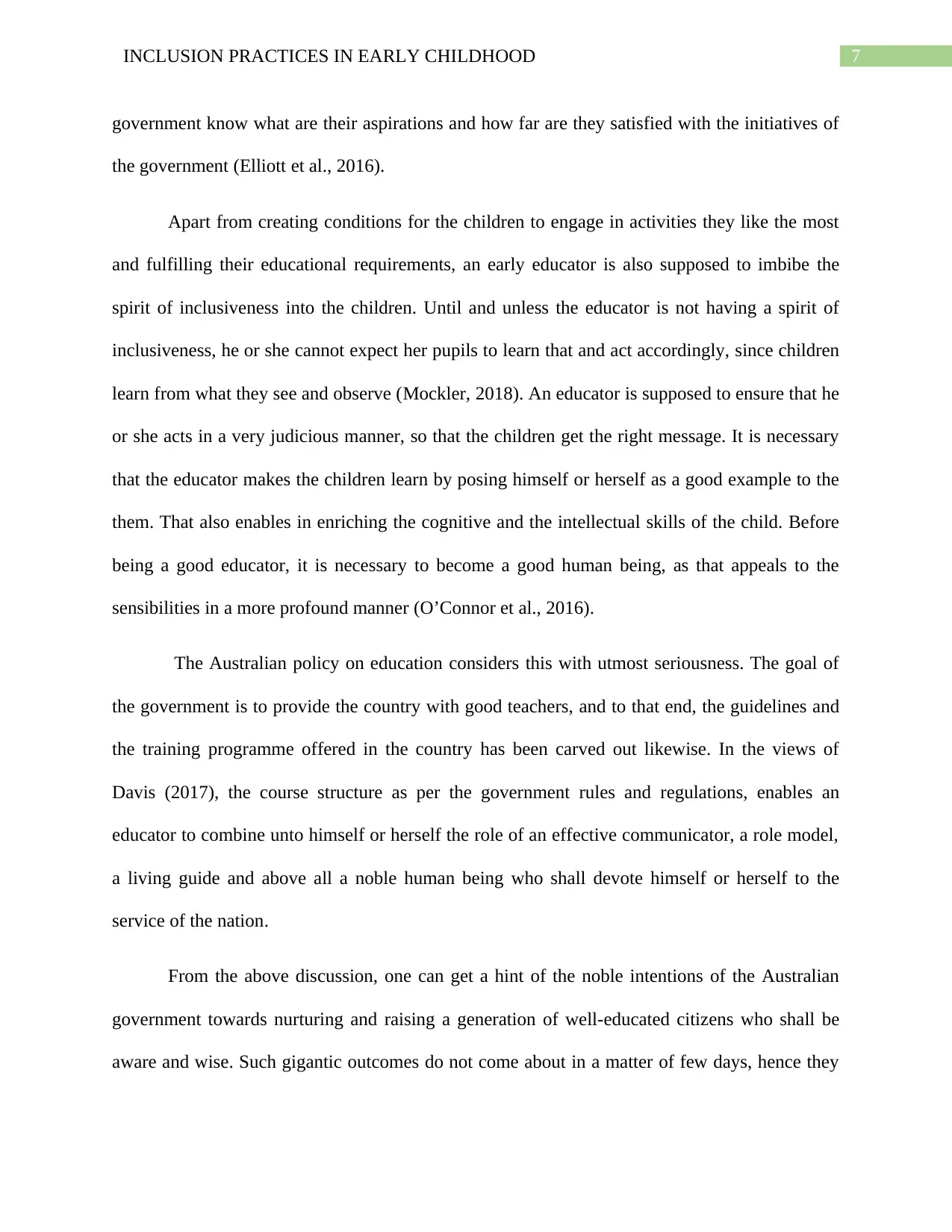
7INCLUSION PRACTICES IN EARLY CHILDHOOD
government know what are their aspirations and how far are they satisfied with the initiatives of
the government (Elliott et al., 2016).
Apart from creating conditions for the children to engage in activities they like the most
and fulfilling their educational requirements, an early educator is also supposed to imbibe the
spirit of inclusiveness into the children. Until and unless the educator is not having a spirit of
inclusiveness, he or she cannot expect her pupils to learn that and act accordingly, since children
learn from what they see and observe (Mockler, 2018). An educator is supposed to ensure that he
or she acts in a very judicious manner, so that the children get the right message. It is necessary
that the educator makes the children learn by posing himself or herself as a good example to the
them. That also enables in enriching the cognitive and the intellectual skills of the child. Before
being a good educator, it is necessary to become a good human being, as that appeals to the
sensibilities in a more profound manner (O’Connor et al., 2016).
The Australian policy on education considers this with utmost seriousness. The goal of
the government is to provide the country with good teachers, and to that end, the guidelines and
the training programme offered in the country has been carved out likewise. In the views of
Davis (2017), the course structure as per the government rules and regulations, enables an
educator to combine unto himself or herself the role of an effective communicator, a role model,
a living guide and above all a noble human being who shall devote himself or herself to the
service of the nation.
From the above discussion, one can get a hint of the noble intentions of the Australian
government towards nurturing and raising a generation of well-educated citizens who shall be
aware and wise. Such gigantic outcomes do not come about in a matter of few days, hence they
government know what are their aspirations and how far are they satisfied with the initiatives of
the government (Elliott et al., 2016).
Apart from creating conditions for the children to engage in activities they like the most
and fulfilling their educational requirements, an early educator is also supposed to imbibe the
spirit of inclusiveness into the children. Until and unless the educator is not having a spirit of
inclusiveness, he or she cannot expect her pupils to learn that and act accordingly, since children
learn from what they see and observe (Mockler, 2018). An educator is supposed to ensure that he
or she acts in a very judicious manner, so that the children get the right message. It is necessary
that the educator makes the children learn by posing himself or herself as a good example to the
them. That also enables in enriching the cognitive and the intellectual skills of the child. Before
being a good educator, it is necessary to become a good human being, as that appeals to the
sensibilities in a more profound manner (O’Connor et al., 2016).
The Australian policy on education considers this with utmost seriousness. The goal of
the government is to provide the country with good teachers, and to that end, the guidelines and
the training programme offered in the country has been carved out likewise. In the views of
Davis (2017), the course structure as per the government rules and regulations, enables an
educator to combine unto himself or herself the role of an effective communicator, a role model,
a living guide and above all a noble human being who shall devote himself or herself to the
service of the nation.
From the above discussion, one can get a hint of the noble intentions of the Australian
government towards nurturing and raising a generation of well-educated citizens who shall be
aware and wise. Such gigantic outcomes do not come about in a matter of few days, hence they
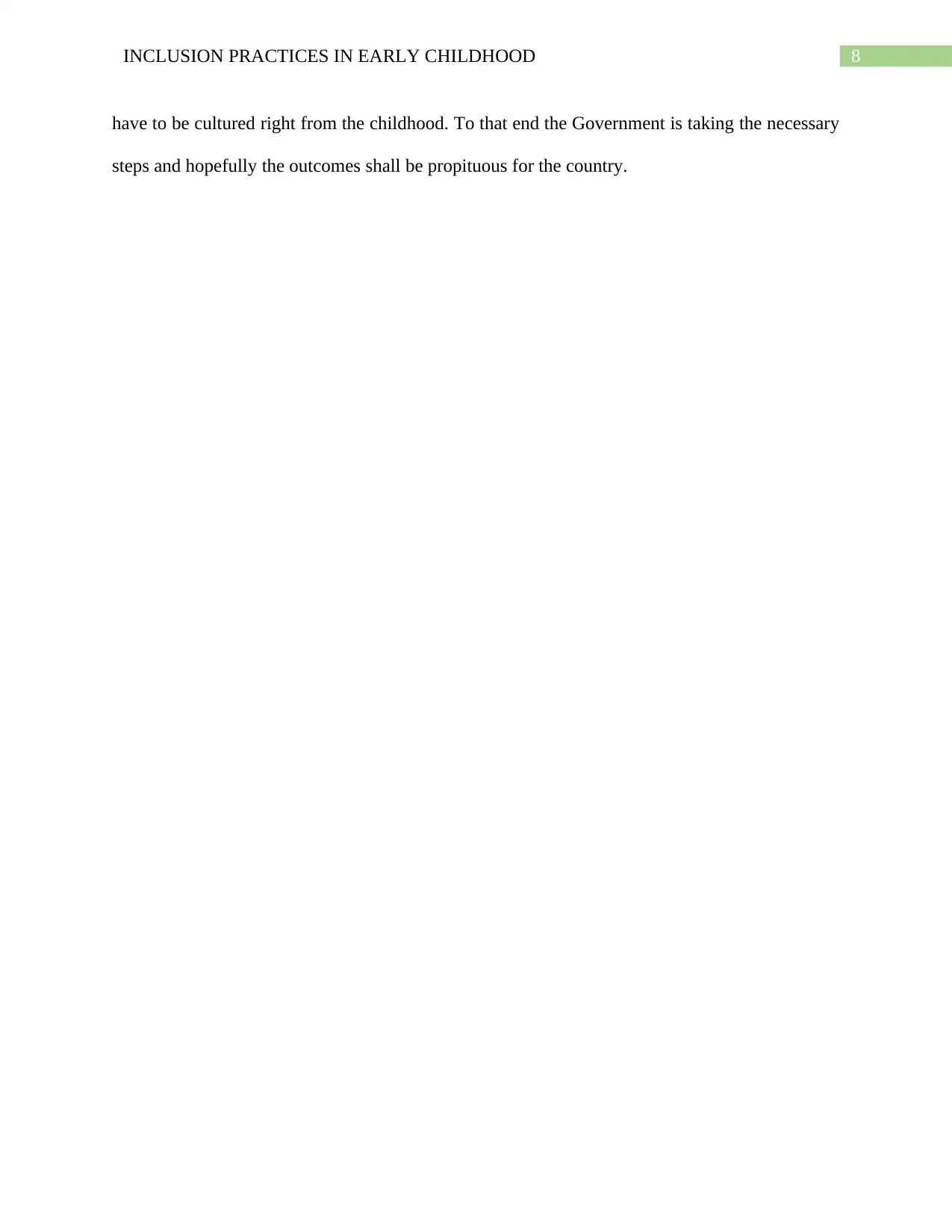
8INCLUSION PRACTICES IN EARLY CHILDHOOD
have to be cultured right from the childhood. To that end the Government is taking the necessary
steps and hopefully the outcomes shall be propituous for the country.
have to be cultured right from the childhood. To that end the Government is taking the necessary
steps and hopefully the outcomes shall be propituous for the country.
⊘ This is a preview!⊘
Do you want full access?
Subscribe today to unlock all pages.

Trusted by 1+ million students worldwide
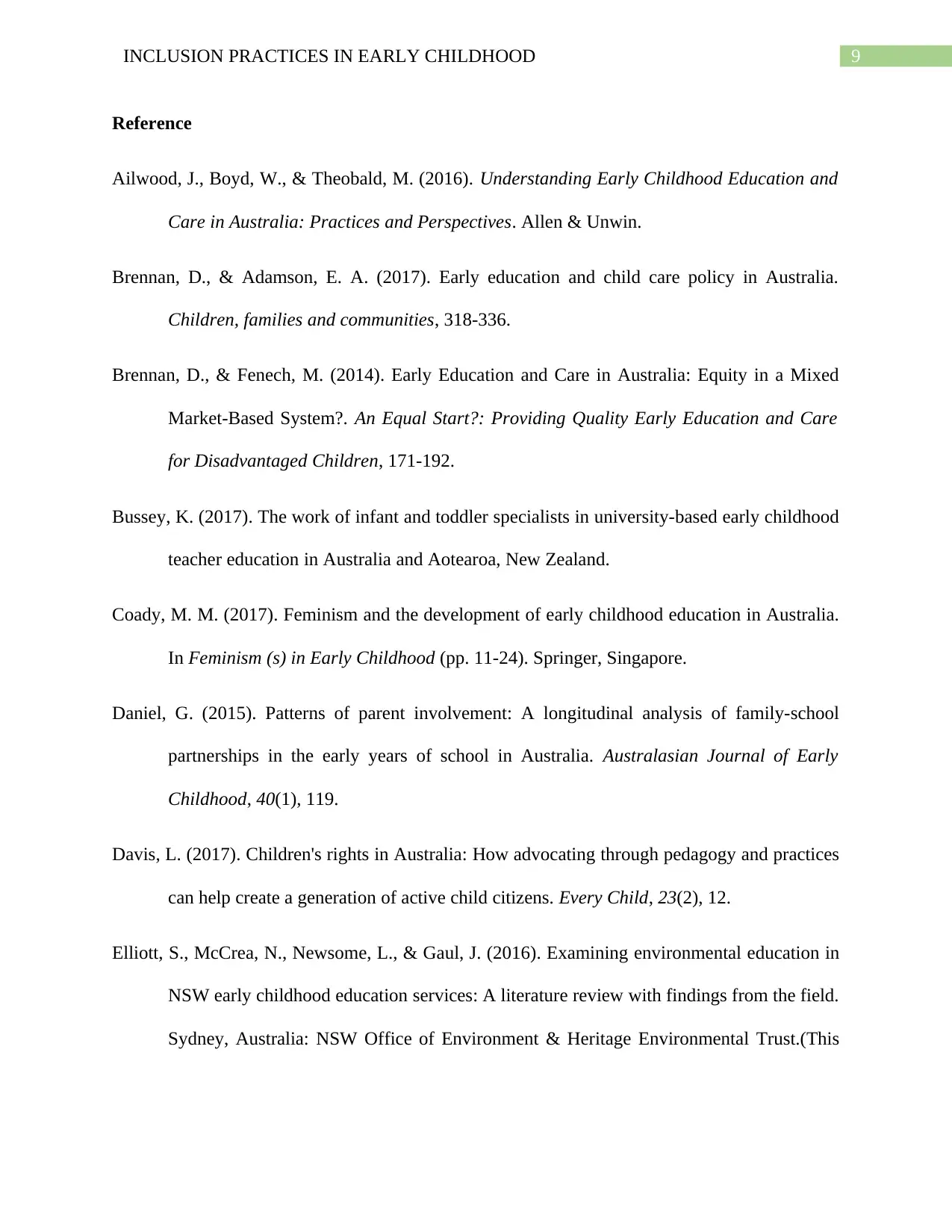
9INCLUSION PRACTICES IN EARLY CHILDHOOD
Reference
Ailwood, J., Boyd, W., & Theobald, M. (2016). Understanding Early Childhood Education and
Care in Australia: Practices and Perspectives. Allen & Unwin.
Brennan, D., & Adamson, E. A. (2017). Early education and child care policy in Australia.
Children, families and communities, 318-336.
Brennan, D., & Fenech, M. (2014). Early Education and Care in Australia: Equity in a Mixed
Market-Based System?. An Equal Start?: Providing Quality Early Education and Care
for Disadvantaged Children, 171-192.
Bussey, K. (2017). The work of infant and toddler specialists in university-based early childhood
teacher education in Australia and Aotearoa, New Zealand.
Coady, M. M. (2017). Feminism and the development of early childhood education in Australia.
In Feminism (s) in Early Childhood (pp. 11-24). Springer, Singapore.
Daniel, G. (2015). Patterns of parent involvement: A longitudinal analysis of family-school
partnerships in the early years of school in Australia. Australasian Journal of Early
Childhood, 40(1), 119.
Davis, L. (2017). Children's rights in Australia: How advocating through pedagogy and practices
can help create a generation of active child citizens. Every Child, 23(2), 12.
Elliott, S., McCrea, N., Newsome, L., & Gaul, J. (2016). Examining environmental education in
NSW early childhood education services: A literature review with findings from the field.
Sydney, Australia: NSW Office of Environment & Heritage Environmental Trust.(This
Reference
Ailwood, J., Boyd, W., & Theobald, M. (2016). Understanding Early Childhood Education and
Care in Australia: Practices and Perspectives. Allen & Unwin.
Brennan, D., & Adamson, E. A. (2017). Early education and child care policy in Australia.
Children, families and communities, 318-336.
Brennan, D., & Fenech, M. (2014). Early Education and Care in Australia: Equity in a Mixed
Market-Based System?. An Equal Start?: Providing Quality Early Education and Care
for Disadvantaged Children, 171-192.
Bussey, K. (2017). The work of infant and toddler specialists in university-based early childhood
teacher education in Australia and Aotearoa, New Zealand.
Coady, M. M. (2017). Feminism and the development of early childhood education in Australia.
In Feminism (s) in Early Childhood (pp. 11-24). Springer, Singapore.
Daniel, G. (2015). Patterns of parent involvement: A longitudinal analysis of family-school
partnerships in the early years of school in Australia. Australasian Journal of Early
Childhood, 40(1), 119.
Davis, L. (2017). Children's rights in Australia: How advocating through pedagogy and practices
can help create a generation of active child citizens. Every Child, 23(2), 12.
Elliott, S., McCrea, N., Newsome, L., & Gaul, J. (2016). Examining environmental education in
NSW early childhood education services: A literature review with findings from the field.
Sydney, Australia: NSW Office of Environment & Heritage Environmental Trust.(This
Paraphrase This Document
Need a fresh take? Get an instant paraphrase of this document with our AI Paraphraser
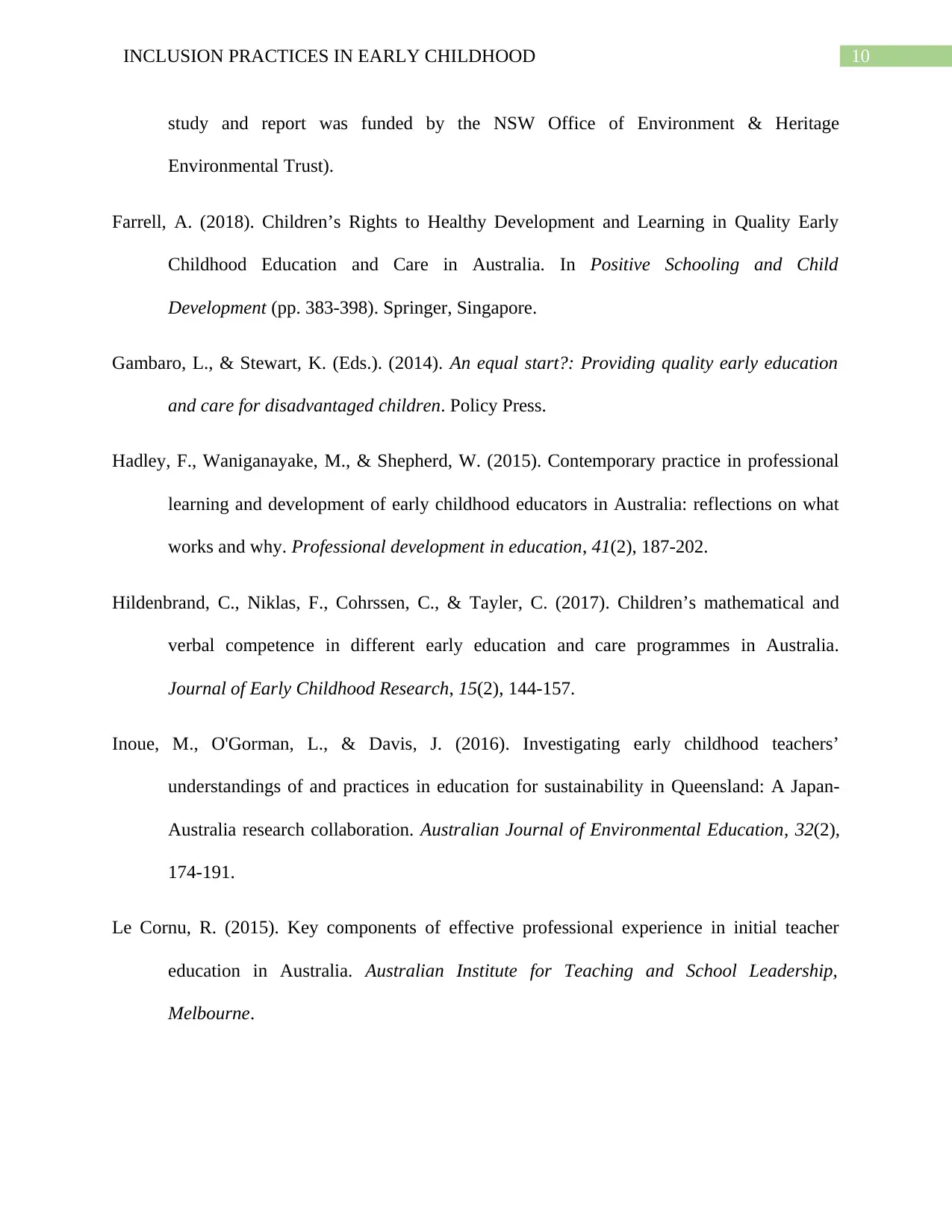
10INCLUSION PRACTICES IN EARLY CHILDHOOD
study and report was funded by the NSW Office of Environment & Heritage
Environmental Trust).
Farrell, A. (2018). Children’s Rights to Healthy Development and Learning in Quality Early
Childhood Education and Care in Australia. In Positive Schooling and Child
Development (pp. 383-398). Springer, Singapore.
Gambaro, L., & Stewart, K. (Eds.). (2014). An equal start?: Providing quality early education
and care for disadvantaged children. Policy Press.
Hadley, F., Waniganayake, M., & Shepherd, W. (2015). Contemporary practice in professional
learning and development of early childhood educators in Australia: reflections on what
works and why. Professional development in education, 41(2), 187-202.
Hildenbrand, C., Niklas, F., Cohrssen, C., & Tayler, C. (2017). Children’s mathematical and
verbal competence in different early education and care programmes in Australia.
Journal of Early Childhood Research, 15(2), 144-157.
Inoue, M., O'Gorman, L., & Davis, J. (2016). Investigating early childhood teachers’
understandings of and practices in education for sustainability in Queensland: A Japan-
Australia research collaboration. Australian Journal of Environmental Education, 32(2),
174-191.
Le Cornu, R. (2015). Key components of effective professional experience in initial teacher
education in Australia. Australian Institute for Teaching and School Leadership,
Melbourne.
study and report was funded by the NSW Office of Environment & Heritage
Environmental Trust).
Farrell, A. (2018). Children’s Rights to Healthy Development and Learning in Quality Early
Childhood Education and Care in Australia. In Positive Schooling and Child
Development (pp. 383-398). Springer, Singapore.
Gambaro, L., & Stewart, K. (Eds.). (2014). An equal start?: Providing quality early education
and care for disadvantaged children. Policy Press.
Hadley, F., Waniganayake, M., & Shepherd, W. (2015). Contemporary practice in professional
learning and development of early childhood educators in Australia: reflections on what
works and why. Professional development in education, 41(2), 187-202.
Hildenbrand, C., Niklas, F., Cohrssen, C., & Tayler, C. (2017). Children’s mathematical and
verbal competence in different early education and care programmes in Australia.
Journal of Early Childhood Research, 15(2), 144-157.
Inoue, M., O'Gorman, L., & Davis, J. (2016). Investigating early childhood teachers’
understandings of and practices in education for sustainability in Queensland: A Japan-
Australia research collaboration. Australian Journal of Environmental Education, 32(2),
174-191.
Le Cornu, R. (2015). Key components of effective professional experience in initial teacher
education in Australia. Australian Institute for Teaching and School Leadership,
Melbourne.
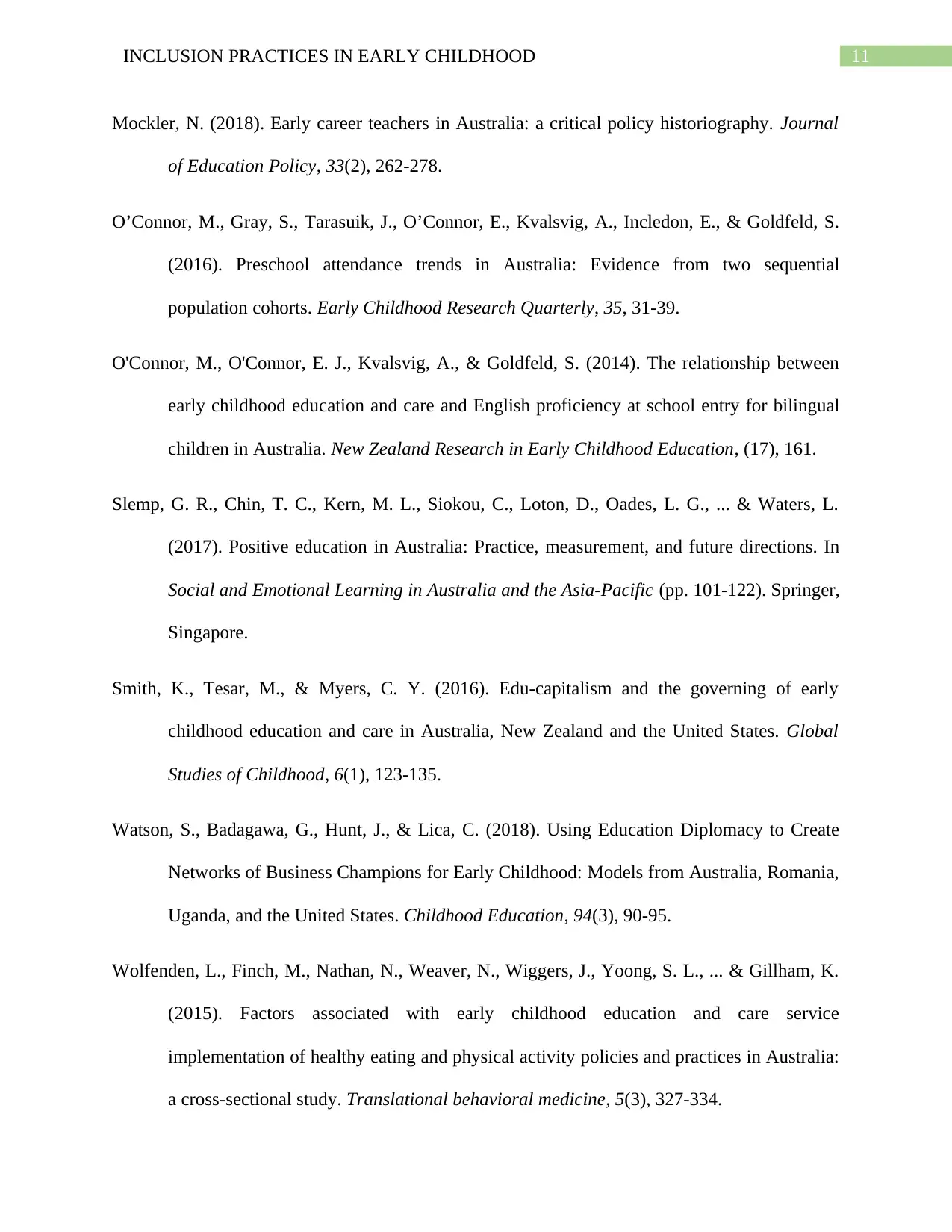
11INCLUSION PRACTICES IN EARLY CHILDHOOD
Mockler, N. (2018). Early career teachers in Australia: a critical policy historiography. Journal
of Education Policy, 33(2), 262-278.
O’Connor, M., Gray, S., Tarasuik, J., O’Connor, E., Kvalsvig, A., Incledon, E., & Goldfeld, S.
(2016). Preschool attendance trends in Australia: Evidence from two sequential
population cohorts. Early Childhood Research Quarterly, 35, 31-39.
O'Connor, M., O'Connor, E. J., Kvalsvig, A., & Goldfeld, S. (2014). The relationship between
early childhood education and care and English proficiency at school entry for bilingual
children in Australia. New Zealand Research in Early Childhood Education, (17), 161.
Slemp, G. R., Chin, T. C., Kern, M. L., Siokou, C., Loton, D., Oades, L. G., ... & Waters, L.
(2017). Positive education in Australia: Practice, measurement, and future directions. In
Social and Emotional Learning in Australia and the Asia-Pacific (pp. 101-122). Springer,
Singapore.
Smith, K., Tesar, M., & Myers, C. Y. (2016). Edu-capitalism and the governing of early
childhood education and care in Australia, New Zealand and the United States. Global
Studies of Childhood, 6(1), 123-135.
Watson, S., Badagawa, G., Hunt, J., & Lica, C. (2018). Using Education Diplomacy to Create
Networks of Business Champions for Early Childhood: Models from Australia, Romania,
Uganda, and the United States. Childhood Education, 94(3), 90-95.
Wolfenden, L., Finch, M., Nathan, N., Weaver, N., Wiggers, J., Yoong, S. L., ... & Gillham, K.
(2015). Factors associated with early childhood education and care service
implementation of healthy eating and physical activity policies and practices in Australia:
a cross-sectional study. Translational behavioral medicine, 5(3), 327-334.
Mockler, N. (2018). Early career teachers in Australia: a critical policy historiography. Journal
of Education Policy, 33(2), 262-278.
O’Connor, M., Gray, S., Tarasuik, J., O’Connor, E., Kvalsvig, A., Incledon, E., & Goldfeld, S.
(2016). Preschool attendance trends in Australia: Evidence from two sequential
population cohorts. Early Childhood Research Quarterly, 35, 31-39.
O'Connor, M., O'Connor, E. J., Kvalsvig, A., & Goldfeld, S. (2014). The relationship between
early childhood education and care and English proficiency at school entry for bilingual
children in Australia. New Zealand Research in Early Childhood Education, (17), 161.
Slemp, G. R., Chin, T. C., Kern, M. L., Siokou, C., Loton, D., Oades, L. G., ... & Waters, L.
(2017). Positive education in Australia: Practice, measurement, and future directions. In
Social and Emotional Learning in Australia and the Asia-Pacific (pp. 101-122). Springer,
Singapore.
Smith, K., Tesar, M., & Myers, C. Y. (2016). Edu-capitalism and the governing of early
childhood education and care in Australia, New Zealand and the United States. Global
Studies of Childhood, 6(1), 123-135.
Watson, S., Badagawa, G., Hunt, J., & Lica, C. (2018). Using Education Diplomacy to Create
Networks of Business Champions for Early Childhood: Models from Australia, Romania,
Uganda, and the United States. Childhood Education, 94(3), 90-95.
Wolfenden, L., Finch, M., Nathan, N., Weaver, N., Wiggers, J., Yoong, S. L., ... & Gillham, K.
(2015). Factors associated with early childhood education and care service
implementation of healthy eating and physical activity policies and practices in Australia:
a cross-sectional study. Translational behavioral medicine, 5(3), 327-334.
⊘ This is a preview!⊘
Do you want full access?
Subscribe today to unlock all pages.

Trusted by 1+ million students worldwide
1 out of 13
Related Documents
Your All-in-One AI-Powered Toolkit for Academic Success.
+13062052269
info@desklib.com
Available 24*7 on WhatsApp / Email
![[object Object]](/_next/static/media/star-bottom.7253800d.svg)
Unlock your academic potential
Copyright © 2020–2025 A2Z Services. All Rights Reserved. Developed and managed by ZUCOL.





